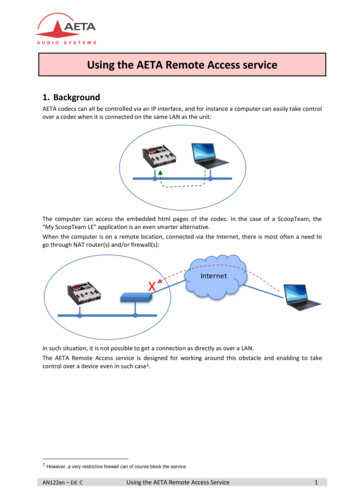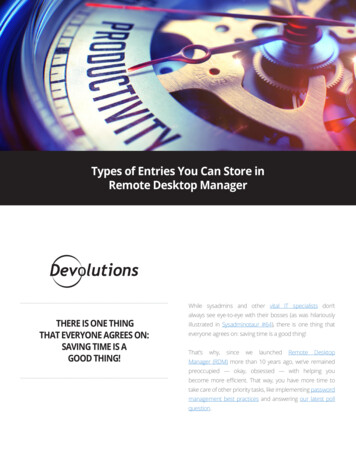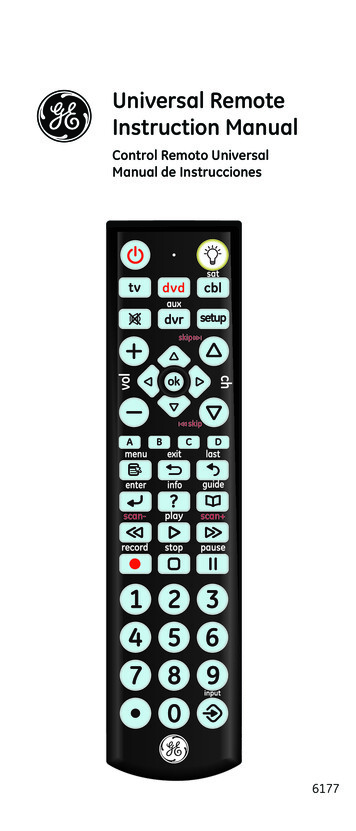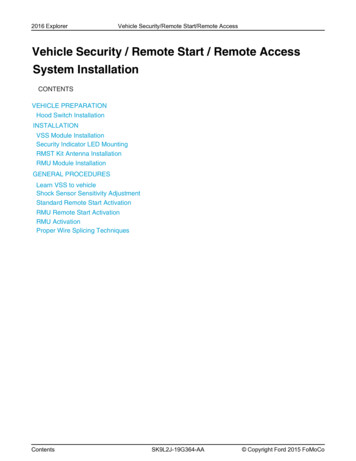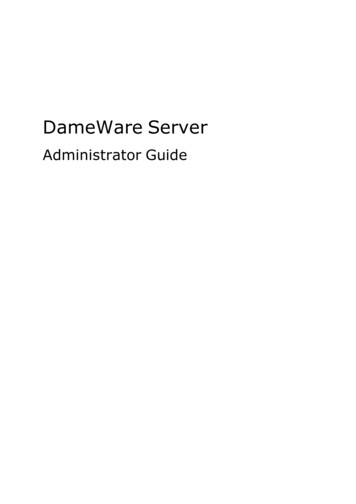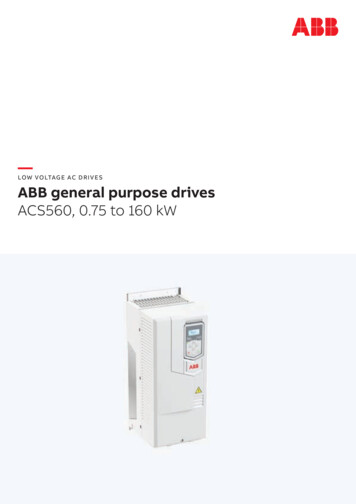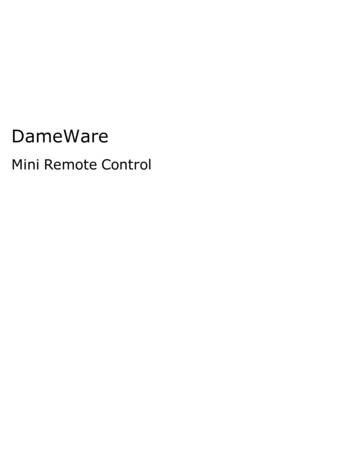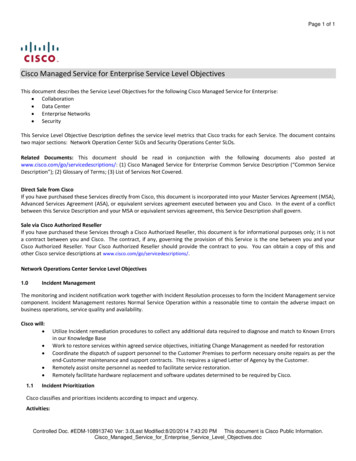
Transcription
Page 1 of 1Cisco Managed Service for Enterprise Service Level ObjectivesThis document describes the Service Level Objectives for the following Cisco Managed Service for Enterprise: Collaboration Data Center Enterprise Networks SecurityThis Service Level Objective Description defines the service level metrics that Cisco tracks for each Service. The document containstwo major sections: Network Operation Center SLOs and Security Operations Center SLOs.Related Documents: This document should be read in conjunction with the following documents also posted atwww.cisco.com/go/servicedescriptions/: (1) Cisco Managed Service for Enterprise Common Service Description (“Common ServiceDescription”); (2) Glossary of Terms; (3) List of Services Not Covered.Direct Sale from CiscoIf you have purchased these Services directly from Cisco, this document is incorporated into your Master Services Agreement (MSA),Advanced Services Agreement (ASA), or equivalent services agreement executed between you and Cisco. In the event of a conflictbetween this Service Description and your MSA or equivalent services agreement, this Service Description shall govern.Sale via Cisco Authorized ResellerIf you have purchased these Services through a Cisco Authorized Reseller, this document is for informational purposes only; it is nota contract between you and Cisco. The contract, if any, governing the provision of this Service is the one between you and yourCisco Authorized Reseller. Your Cisco Authorized Reseller should provide the contract to you. You can obtain a copy of this andother Cisco service descriptions at www.cisco.com/go/servicedescriptions/.Network Operations Center Service Level ObjectivesIncident Management1.0The monitoring and incident notification work together with Incident Resolution processes to form the Incident Management servicecomponent. Incident Management restores Normal Service Operation within a reasonable time to contain the adverse impact onbusiness operations, service quality and availability.Cisco will: 1.1Utilize Incident remediation procedures to collect any additional data required to diagnose and match to Known Errorsin our Knowledge BaseWork to restore services within agreed service objectives, initiating Change Management as needed for restorationCoordinate the dispatch of support personnel to the Customer Premises to perform necessary onsite repairs as per theend-Customer maintenance and support contracts. This requires a signed Letter of Agency by the Customer.Remotely assist onsite personnel as needed to facilitate service restoration.Remotely facilitate hardware replacement and software updates determined to be required by Cisco.Incident PrioritizationCisco classifies and prioritizes incidents according to impact and urgency.Activities:Controlled Doc. #EDM-108913740 Ver: 3.0Last Modified:8/20/2014 7:43:20 PM This document is Cisco Public Information.Cisco Managed Service for Enterprise Service Level Objectives.doc
Page 2 of 1 Evaluate Incident severity and prioritize all Incidents into Priority 1 (P1), Priority 2 (P2), Priority 3 (P3) and Priority 4 (P4)Incident categoriesClassify Incidents into Fault or Performance Incident categories as appropriate Deliverable(s): Properly prioritized Incidents based on Incident Ticketing attributesProperly classified Incident based on the Incident Ticketing attributes1.1.1Impact DefinitionsAn Incident is classified according to its impact on the business (the size, scope, and complexity of the Incident).Impact is a measure of the business criticality of an Incident or Problem, often equal to the extent to which an Incidentleads to degradation of a Service running on the Network. Cisco shall work with Customer to specify impact for eachManaged Component during Transition Management.There are four impact levels: 1.1.2Widespread: Entire Network is affected (more than three quarters of individuals, sites or devices)Large: Multiple sites are affected (between one-half and three-quarters of individuals, sites or devices)Localized: Single site, room and/or multiple users are affected (between one-quarter and one-half ofindividuals, sites or devices)Individualized: A single user or meeting is affected (less than one-quarter of individuals, sites or devices)Urgency DefinitionUrgency defines the criticality of the Incident or Problem to the Customer’s business. Cisco shall work with the Customer tounderstand and set the proper urgency level.Cisco Incident and Problem urgency levels are defined as follows: Critical – Primary business function is stopped with no redundancy or backup. There may be an immediate financialimpact to the Customer’s business. The Customer determines the issue as critical.High – Primary business function is severely degraded or supported by backup or redundant system. There is aprobable significant financial impact to the Customer’s business. The Customer perceives the issue as high.Medium – Non-critical business function is stopped or severely degraded. There is a possible financial impact to theCustomer’s business. The Customer perceives the issue as medium.Low - Non-critical business function is degraded. There is little or no financial impact. The Customer perceives theissue as low.Priority Definitions1.2Priority defines the level of effort that will be expended by Cisco and the Customer to resolve the Incident.Cisco Incident Management priorities are defined as follows:1.2.3.P1: Critical – Cisco and the Customer will commit any necessary resources 24x7 to resolve the situation.P2: High – Cisco and the Customer will commit full-time resources during Standard Business Hours to resolve thesituation.P3: Medium – Cisco and the Customer are willing to commit resources during Standard Business Hours to restore serviceto satisfactory levels.Controlled Doc. #EDM-108913740 Ver: 3.0Last Modified:8/20/2014 7:43:20 PM This document is Cisco Public Information.Cisco Managed Service for Enterprise Service Level Objectives.doc
Page 3 of 14.P4: Low - Cisco and the Customer are willing to commit resources during Standard Business Hours to provide informationor P3P3LowP4P4P4P4Cisco will downgrade the ticket priority in accordance with reduced severity of impact or Incident resolution. The case maybe left open for a prescribed period while operational stability is being assessed.Incident Ticket shall be closed by Cisco or Customer upon validation of issue remediation and the systems return tooperational stability.Ticket detail resides in a Knowledge Base which is used to support Incident Management and Problem Managementprocesses.Service Level Objectives2.0Service Level Objectives apply only to Managed Components that are managed exclusively by Cisco within the Service. Cisco adheresto the SLOs during the Service Delivery phase. 1 Within the Service Activation Kit, the Customer and Cisco must document theiragreement to formally acknowledge the completion of the Transition Management process. The Service Delivery phase commencesupon mutual agreement between Cisco and the Customer that the Transition Management phase is complete and that the ServiceDelivery phase has been reached.The following Incident metrics are tracked as Service Level Objectives: Time to Change (TTC) Time to Notify (TTN) Time to Restore (TTR)2.1Time to ChangeCisco has categorized Defined Changes into Types based on level of complexity and the amount of time required to complete thechange. All Elective Changes are scheduled events and are dependent on coordination with Customer schedule. A change requestmust be fully qualified and scheduled with the customer before the Time to Change metric starts. All custom scope Elective Changerequests are scheduled events and follow Change Management procedures.Additional details are available in the individual technology addendums and outline the specific change types. The chart belowprovides a break-down of the available categories and durations for Small, Medium, and Large changes.1Cisco cannot adhere to the SLOs during the Transition Management phase. Within the Service Activation Kit, the Customer and Cisco must documentthe exit criteria for the Transition Management phase.Controlled Doc. #EDM-108913740 Ver: 3.0Last Modified:8/20/2014 7:43:20 PM This document is Cisco Public Information.Cisco Managed Service for Enterprise Service Level Objectives.doc
Page 4 of 1CategorySizeType 1SmallType 2SmallType 3MedType 4MedType 5MedType 6LargeType7LargeType 8LargeCisco Service Level Objectives (SLO) for completing approved Change request is as follows:Change Type*Time to completion fromreceipt of fully qualifiedand scheduled changerequestTypes 1 and 23 Business DaysUp to 12 changes per customerper business dayTypes 3 and 4Within 5 business Days**Up to 6 changes per customerper business dayType 5 - 8No SLO, scheduled*Note: See specific Technology Addendums for individual change type categories.**Note: SLO time commences when all necessary detail to execute the change is available.Business days are Monday through Friday, excluding Cisco-observed holidays.SLO measurements exclude the following: Delays caused by Customer in executing the requested change (for example, waiting for response on change window)Any mutually agreed schedule of activities that causes service levels to fall outside of measured SLO defined obligations.Other factors outside of Cisco’s reasonable control for which Cisco is not responsibleCisco or third party hardware dispatch and replacementSMARTnet cycle time is not included in the SLO measurement.Ticket closure time may be different than change completion time. For example: a ticket may be kept open for reviewafter the change has been executed.Controlled Doc. #EDM-108913740 Ver: 3.0Last Modified:8/20/2014 7:43:20 PM This document is Cisco Public Information.Cisco Managed Service for Enterprise Service Level Objectives.doc
Page 5 of 1Any Customer-requested changes that are considered by the Customer as “emergency” or “urgent” changes will be treated on acommercially reasonable effort by the Cisco NOC/SOC and will depend on Cisco NOC/SOC engineer availability at the time ofsubmittal. Additional charges may apply. See the Common Service Description for details.Time to Notify (TTN)*2.2Customers may have specific incident notification requirements of which the Service will offer a Time to Notify objective. Cisco willrespond to incidents raised through the management platform by electronically notifying a specified Customer contact(s) within theTTN timeframe. Cisco SLO for meeting this objective is as follows: “Electronic notifications may be generated automatically and sent to customer contacts as specified during the TransitionManagement phase.”Cisco estimated time to notify designated Customer contactIncident Level15 Minutes from ticket creationAll Priority IncidentsTime to Restore (TTR)2.3Incidents go through many stages with restoration being a primary objective. Time to restore tickets includes all remote incidentmanagement activities (alarm or call receipt through restore, excluding maintenance or carrier cycle time). Time to Restore shallmean the time period occurrence of the Incident until Cisco restores the Managed Component to a usable level of functionality.Cisco SLO for meeting this objective is as follows:Cisco estimated time to restore an incidentticketIncident Level4 HoursP1 incidents12 HoursP2 incidents72 HoursP3 incidents120 HoursP4 incidentsSLO measurements exclude the following: Delays caused by Customer in resolving the qualifying issue (for example, waiting for response on change window or onsite resources)Any mutually agreed schedule of activities that causes service levels to fall outside of measured SLO defined obligations.Delays or faults caused by third party equipment or vendors, such as Carriers in resolving the qualifying issueOther factors outside of Cisco’s reasonable control for which Cisco is not responsibleCisco or third party hardware dispatch and replacementControlled Doc. #EDM-108913740 Ver: 3.0Last Modified:8/20/2014 7:43:20 PM This document is Cisco Public Information.Cisco Managed Service for Enterprise Service Level Objectives.doc
Page 6 of 1 Acquisition and installation time of new software to be installed on the Managed Component due to software defects orbugsSMARTnet cycle time is not included in the SLO measurement.Security Operations Center Service Level Objectives3.0The nature of Security Operations differs from Network Operations sufficiently to demand separate Service Level Objectives. TheService Level Objectives for the following Cisco Managed Service for Security Service Levels are described in the document below: MonitoringManagementService Level ObjectivesThe following Incident metrics are tracked as Service Level Objectives specifically for Security Managed Service and pertain tosecurity events and not fault events.A fault or performance event is specific to the availability and performance of the actual security device.A security event is defined as anything detected which is considered malicious in nature or intended to cause degradation to thenetwork resources and / or assets.Service Level Management for Cisco Managed Service for SecurityOnce the event is determined to be anomalous in nature or a security threat, that event is then classified within the Mean Time toClassify (MTTC) objective.Security Incident Classification Codes: Benign: Traffic that is not harmful to network integrity. Attack: An attempt to gain unauthorized access to protected data or deny access to networks. Denial of service (DoS): An attempt to saturate the network resources. Malware: Detection of software designed to infiltrate or cause damage to resources. Misuse: Internal misuse of network and data resources. Recon: Scanning a network for vulnerabilities. Suspicious traffic: Not enough data available to rule out an attack and classify it as benign.The MTTC SLO objective is 30 minutesControlled Doc. #EDM-108913740 Ver: 3.0Last Modified:8/20/2014 7:43:20 PM This document is Cisco Public Information.Cisco Managed Service for Enterprise Service Level Objectives.doc
_Objectives.doc Evaluate Incident severity and prioritize all Incidents into Priority 1 (P1), Priority 2 (P2), Priority 3 (P3) and Priority 4 (P4) Incident categories Classify Incidents into Fault or Performance Incident categories as appropriate Deliverable(s):

